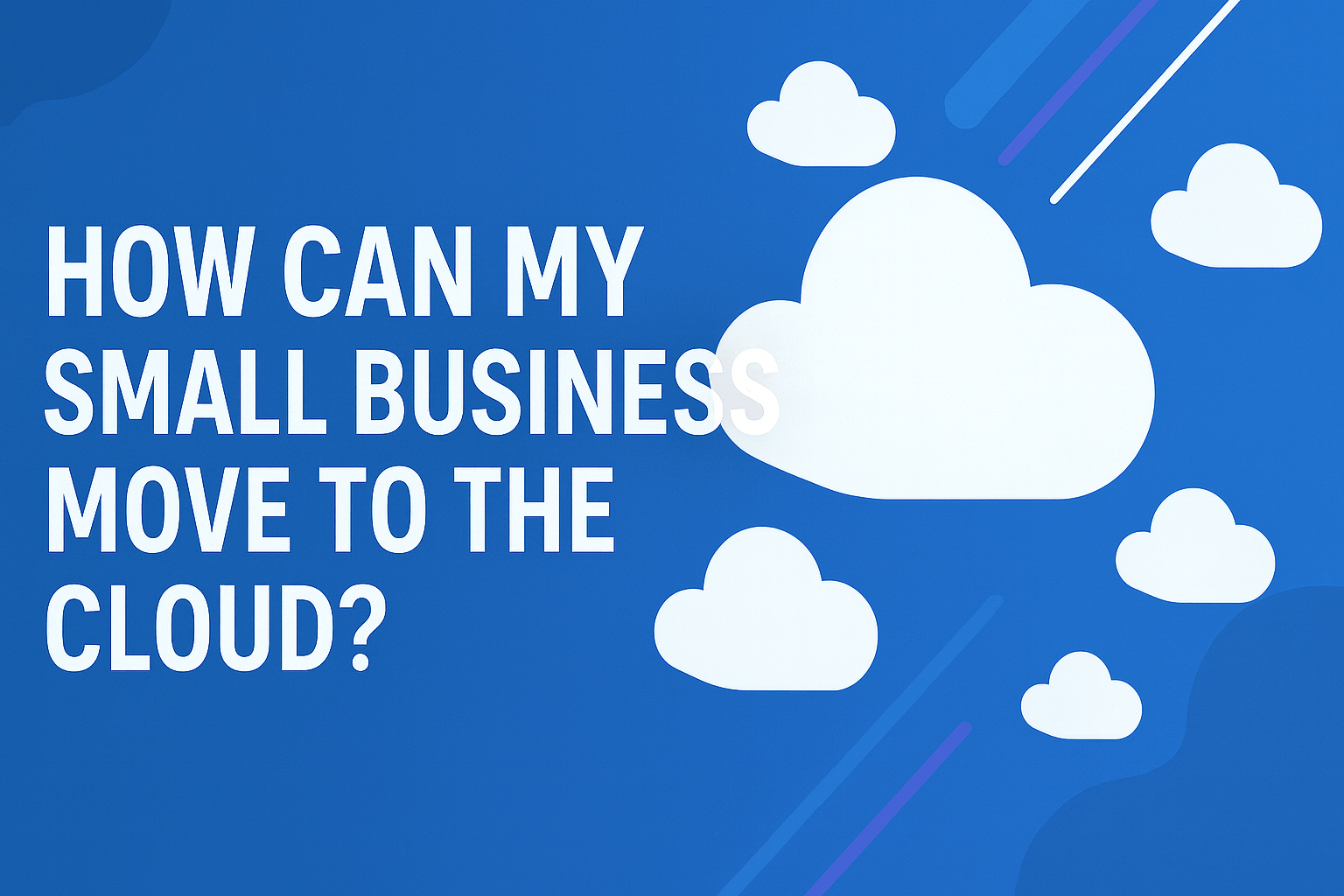How Can My Small Business Move to the Cloud?
For many small and medium-sized businesses (SMBs), moving to the cloud feels like a big step. You may be asking yourself: Is it worth it? How much will it cost? Who can help me do it right? The good news is that cloud technology is no longer just for large enterprises. It’s now affordable, flexible, and accessible for businesses of every size.
In this article, we’ll break down what the cloud is, why it benefits small businesses, and how your business can successfully make the move.

What Does “Moving to the Cloud” Actually Mean?
“Moving to the cloud” simply means shifting some (or all) of your business’s IT systems, software, and data from physical servers or local devices into secure, internet-based services. Instead of running everything in-house, you use online platforms such as Microsoft 365, Google Workspace, or cloud storage providers.
This could include:
- Email and collaboration tools (e.g., Microsoft Teams, Outlook)
- File storage and backup
- Business applications (CRM, accounting, project management tools)
- Servers and networking
If you’re not sure which systems to move first, why not speak with an IT expert to map out the best starting point for your business?
Why Should a Small Business Move to the Cloud?
Here are the biggest benefits for SMBs:
1. Cost Savings
No more expensive upfront hardware costs or ongoing maintenance. Cloud services run on subscription models, so you pay monthly or annually for what you use.
If controlling IT costs is a priority, consider booking a quick consultation to see how cloud subscriptions could reduce your expenses.
2. Flexibility and Scalability
Whether you’re a team of 5 or 50, cloud systems scale as your business grows. Adding users or storage takes minutes, not weeks.
3. Remote and Hybrid Working
The cloud allows your employees to securely access files and tools from anywhere – essential for flexible and remote work.
If your team works remotely, now is the time to explore cloud collaboration tools that make day-to-day operations seamless.
4. Security and Backup
Reputable cloud providers offer strong security measures, including encryption, regular backups, and disaster recovery.
5. Business Continuity
If your office internet goes down or a laptop fails, your data remains safe and accessible in the cloud.
Don’t leave your business continuity to chance – get in touch to discuss disaster recovery options that fit your business size.
How to Move Your Small Business to the Cloud
Transitioning to the cloud doesn’t have to be overwhelming. Follow these steps:
Step 1: Assess Your Needs
Identify what IT systems and applications you currently use. Which ones could benefit from being in the cloud? Common starting points for SMBs include email, file storage, and collaboration tools.
Need help figuring this out? Contact us for a free assessment of your current IT setup.
Step 2: Choose the Right Cloud Services
Popular options for SMBs include:
- Microsoft 365 (email, Teams, SharePoint, OneDrive)
- Google Workspace (Gmail, Drive, Meet)
- Cloud storage providers (Dropbox, Box)
- Industry-specific applications (accounting, HR, CRM systems)
If you’re unsure which platform best suits your business, give us a call and we’ll guide you through your options.
Step 3: Plan the Migration
Work with an IT partner to create a step-by-step migration plan. This ensures minimal disruption and data security during the move.
Step 4: Train Your Team
User adoption is key. Provide training so your staff know how to get the most from the new cloud tools.
We regularly provide training for SMBs moving to Microsoft 365 – ask us about tailored staff workshops.
Step 5: Secure and Monitor
Once you’re live, ensure your systems are protected with strong passwords, multi-factor authentication, and ongoing monitoring.
Speak to us about setting up ongoing IT monitoring and support so your systems remain secure and efficient.
Do You Need Help Moving to the Cloud?
For many small businesses, the hardest part is knowing where to start. That’s where working with an IT partner like Techfident makes all the difference. We help SMBs choose the right cloud solutions, manage the migration process, and provide ongoing support so your business can thrive.
No jargon, no hidden costs – just straightforward cloud solutions tailored to your needs.
Ready to take the first step? Fill out our online form or give us a call today to get started with your cloud migration.
About Techfident
At Techfident, we specialise in supporting small and medium-sized businesses with practical, cost-effective IT solutions. From cloud migrations to hardware supply and managed IT support, our team has the expertise to keep your business running smoothly. We’re trusted by SMBs across the UK to deliver reliable, jargon-free IT support that scales as they grow.
If you’re looking for a trusted partner to guide your move to the cloud, get in touch with Techfident today – and let’s make your IT work smarter for your business.




